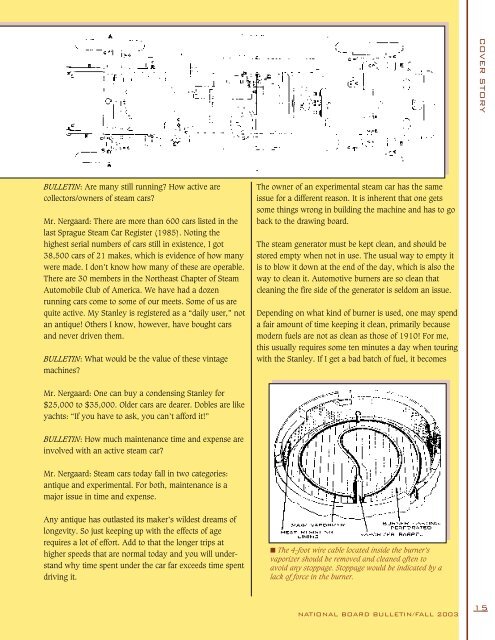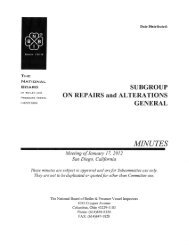bulletin - The National Board of Boiler and Pressure Vessel Inspectors
bulletin - The National Board of Boiler and Pressure Vessel Inspectors
bulletin - The National Board of Boiler and Pressure Vessel Inspectors
Create successful ePaper yourself
Turn your PDF publications into a flip-book with our unique Google optimized e-Paper software.
BULLETIN: Are many still running? How active are<br />
collectors/owners <strong>of</strong> steam cars?<br />
Mr. Nergaard: <strong>The</strong>re are more than 600 cars listed in the<br />
last Sprague Steam Car Register (1985). Noting the<br />
highest serial numbers <strong>of</strong> cars still in existence, I got<br />
38,500 cars <strong>of</strong> 21 makes, which is evidence <strong>of</strong> how many<br />
were made. I don’t know how many <strong>of</strong> these are operable.<br />
<strong>The</strong>re are 30 members in the Northeast Chapter <strong>of</strong> Steam<br />
Automobile Club <strong>of</strong> America. We have had a dozen<br />
running cars come to some <strong>of</strong> our meets. Some <strong>of</strong> us are<br />
quite active. My Stanley is registered as a “daily user,” not<br />
an antique! Others I know, however, have bought cars<br />
<strong>and</strong> never driven them.<br />
BULLETIN: What would be the value <strong>of</strong> these vintage<br />
machines?<br />
Mr. Nergaard: One can buy a condensing Stanley for<br />
$25,000 to $35,000. Older cars are dearer. Dobles are like<br />
yachts: “If you have to ask, you can’t afford it!”<br />
BULLETIN: How much maintenance time <strong>and</strong> expense are<br />
involved with an active steam car?<br />
Mr. Nergaard: Steam cars today fall in two categories:<br />
antique <strong>and</strong> experimental. For both, maintenance is a<br />
major issue in time <strong>and</strong> expense.<br />
Any antique has outlasted its maker’s wildest dreams <strong>of</strong><br />
longevity. So just keeping up with the effects <strong>of</strong> age<br />
requires a lot <strong>of</strong> effort. Add to that the longer trips at<br />
higher speeds that are normal today <strong>and</strong> you will underst<strong>and</strong><br />
why time spent under the car far exceeds time spent<br />
driving it.<br />
<strong>The</strong> owner <strong>of</strong> an experimental steam car has the same<br />
issue for a different reason. It is inherent that one gets<br />
some things wrong in building the machine <strong>and</strong> has to go<br />
back to the drawing board.<br />
<strong>The</strong> steam generator must be kept clean, <strong>and</strong> should be<br />
stored empty when not in use. <strong>The</strong> usual way to empty it<br />
is to blow it down at the end <strong>of</strong> the day, which is also the<br />
way to clean it. Automotive burners are so clean that<br />
cleaning the fire side <strong>of</strong> the generator is seldom an issue.<br />
Depending on what kind <strong>of</strong> burner is used, one may spend<br />
a fair amount <strong>of</strong> time keeping it clean, primarily because<br />
modern fuels are not as clean as those <strong>of</strong> 1910! For me,<br />
this usually requires some ten minutes a day when touring<br />
with the Stanley. If I get a bad batch <strong>of</strong> fuel, it becomes<br />
■ <strong>The</strong> 4-foot wire cable located inside the burner’s<br />
vaporizer should be removed <strong>and</strong> cleaned <strong>of</strong>ten to<br />
avoid any stoppage. Stoppage would be indicated by a<br />
lack <strong>of</strong> force in the burner.<br />
NATIONAL BOARD BULLETIN/FALL 2003<br />
COVER STORY<br />
15








